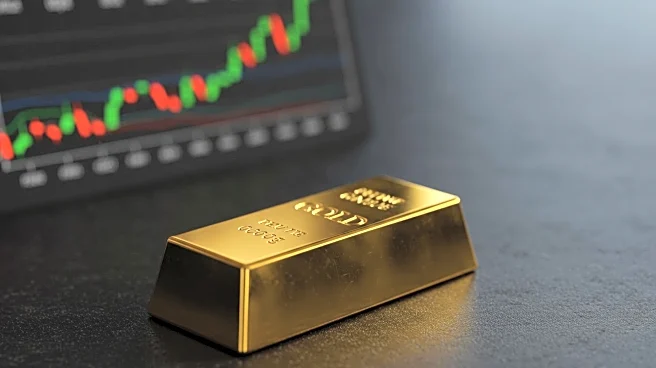What's Happening?
Gold prices have experienced fluctuations as market participants react to recent U.S. economic data and Federal Reserve rate cut expectations. On Thursday, gold extended its gains for a third consecutive session, driven by the anticipation of a potential interest rate cut by the Federal Reserve in September. This expectation was fueled by tame inflation data, which also contributed to a weaker dollar. However, the release of hotter-than-expected U.S. inflation data and a decrease in jobless claims led to a rise in the dollar and Treasury yields, reducing the likelihood of a significant rate cut. Spot gold fell 0.5% to $3,337.21 per ounce, while U.S. gold futures for December delivery settled 0.7% lower at $3,383.2. The stronger U.S. wholesale price data has tempered expectations for a larger rate cut, with traders now leaning towards a quarter-point move next month.
Why It's Important?
The fluctuations in gold prices highlight the sensitivity of the precious metals market to U.S. economic indicators and Federal Reserve policy decisions. Gold, traditionally seen as a safe haven during economic uncertainty, benefits from low interest rates, which reduce the opportunity cost of holding non-yielding bullion. The current economic data suggests a complex scenario for the Federal Reserve, which must balance inflation control with economic support. A potential rate cut could stimulate economic activity but may also signal concerns about economic growth. The outcome of these decisions will impact investors, financial markets, and the broader economy, influencing investment strategies and economic forecasts.
What's Next?
Market participants will closely monitor upcoming economic data releases and Federal Reserve communications for further indications of monetary policy direction. The Federal Reserve's next meeting in September will be pivotal, as it will provide clarity on the central bank's stance regarding interest rates. Traders and analysts will assess the likelihood of a rate cut and its potential size, with implications for gold prices and broader financial markets. Additionally, geopolitical developments and other economic indicators will continue to influence market sentiment and investment decisions.












